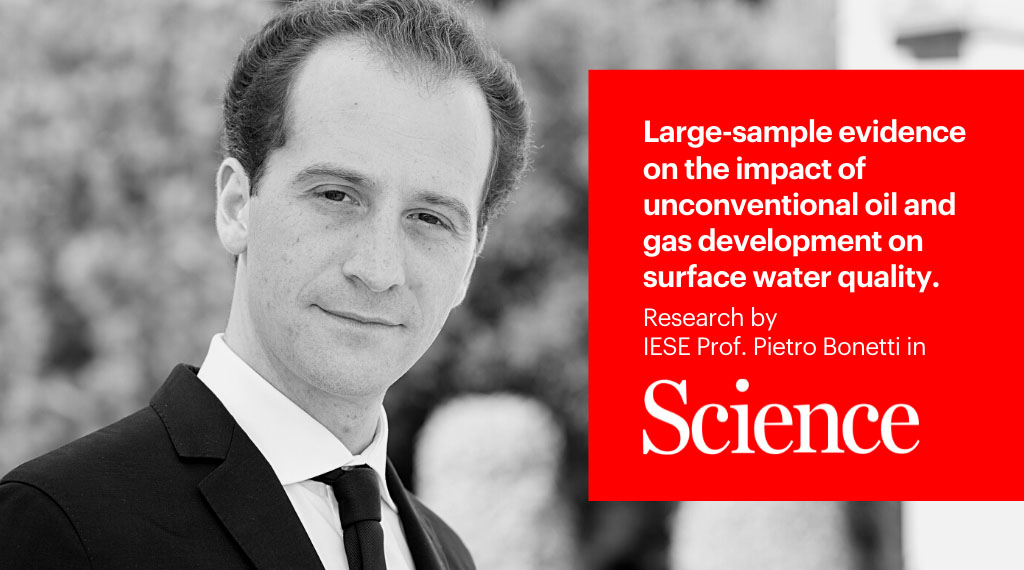Stories
IESE research in Science magazine: Hydraulic fracturing may be impacting surface waters
Prof. Pietro Bonetti finds evidence tying fracking to increased salt concentrations in surface waters
The research was authored by professors from IESE, Chicago Booth and the University of Bristol.
Photo: IESE
August 20, 2021

New research published in the prestigious journal Science finds that fracking is linked to higher salt concentration in surface waters. The research, authored by professors from IESE, Chicago Booth and the University of Bristol, concludes that better water measurement is needed in order to fully understand the environmental impact of fracking.
The article, “Large-Sample Evidence on the Impact of Unconventional Oil and Gas Development on Surface Waters,” is published in the August 2021 edition of Science.
The discovery of hydraulic fracturing, better known as fracking, is considered by many to be the most important change in the energy sector since the introduction of nuclear-generated electricity more than 50 years ago — and a controversial one. US production of oil and natural gas has increased, energy prices have fallen, and domestic energy security has strengthened as the US has relied more on fracked oil and less on imports.
But critics point to health and environmental concerns, especially the threat fracking could pose to water supplies.
Some studies have documented groundwater contamination related to fracking, but surface water may also be at risk: IESE’s Pietro Bonetti, Chicago Booth’s Christian Leuz, and University of Bristol’s Giovanna Michelon find evidence tying fracking to increased salt concentrations in surface waters across several US shales and many watersheds.
While the elevated levels they discovered were very small and within the bounds of what the US Environmental Protection Agency considers safe, the researchers note that better water quality data is needed to fully understand the surface water impact of unconventional oil and gas development.
Previous studies focused on groundwater
Fracking allows the energy industry to reach oil and gas stores that are otherwise unavailable, which it does by injecting millions of gallons of liquid underground, at a high pressure, in order to create fractures in rocks to allow oil or gas to flow.
While the industry maintains that the process is safe, others have raised concerns regarding the fracking fluid (a mix of water and chemical additives and propping agents such as sand) and the large amounts of resulting wastewater, which includes both flowback from the fracking fluid and produced water from the deep formations. The latter brine is naturally occurring water, into which organic and inorganic constituents from the formation have dissolved, resulting in high salt concentrations.
While studies such as a 2011 paper by Duke’s Stephen G. Osborn, Avner Vengoshb, Nathaniel R. Warnerb and Robert B. Jackson have linked fracking to groundwater contamination, there has been less evidence tying the process to surface water contamination, other than to isolated spills and leaks. But Bonetti, Leuz, and Michelon’s research suggests fracking may lead to increased salt concentrations in surface waters.
The researchers used a geo-coded database that combined surface water measurements with 46,479 hydraulic fracturing wells from 24 shales across 408 watersheds from 2006 to 2016. They specifically looked for concentrations of bromide, chloride, barium and strontium because these ions are usually found in high concentrations in flowback and produced water from wells, and they do not biodegrade and have been found several years after spills. Using a statistical approach, Bonetti, Leuz, and Michelon identified anomalous changes in ion concentration associated with new wells in the same watersheds.
Small but consistent increases in barium, chloride and strontium
In areas where there were new hydraulic fracturing wells, there were also elevated salt concentrations in surface waters, according to the researchers, who find small but consistent increases in barium, chloride and strontium concentrations, but not bromide. These elevated levels existed in Pennsylvania — which accounted for almost 41 percent of the sample — and for all US watersheds at comparable magnitude and significance.
The increases in salt levels were largest during the early phases of production when wells generate large amounts of flowback and produced water, which suggests a link between elevated concentrations and the unconventional oil and gas development process, according to the research. The salt concentrations were most pronounced for wells that produced larger amounts of water and for wells located in areas where the deep formations exhibited higher levels of salinity.
The elevated levels the researchers discovered were well below the US Environmental Protection Agency’s limits and advisory levels for what is considered safe. However, the water measurements were predominantly taken from rivers, and it is important to recognize that not all wells are close to surface water and not all monitors are in locations where they could detect an effect, the researchers argue. In addition, they write, the study was hampered by the availability and measurement frequency of water quality data. Hydraulic fracturing fluids contain chemical substances that are potentially more dangerous than salts, but Bonetti, Leuz, and Michelon weren’t able to look for these chemicals, as they’re not widely covered by public databases.
As such, the research shows “we need better and more frequent monitoring and water measurement to get a greater understanding of the environmental implications of fracking,” says Bonetti. “For instance, federal and state environmental agencies could consider placing monitoring stations in a more targeted fashion to better track potential water-quality impacts. More extensive water measurement for a broader array of substances clearly requires adequate funding for these agencies.”
Read the full article “Large-Sample Evidence on the Impact of Unconventional Oil and Gas Development on Surface Waters,” Science, August 2021.
Read an interview with Prof. Bonetti discussing the research.


